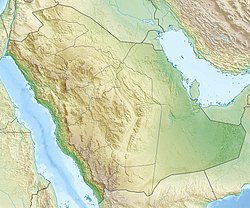| Adaffa Formation | |
|---|---|
| Stratigraphic range: Campanian ~ | |
| Type | Geological formation |
| Unit of | Suqah Group |
| Underlies | Unconformity with Lower Miocene Al Wajh Formation |
| Overlies | Proterozoic granite basement |
| Thickness | Up to 200 m (660 ft) |
| Lithology | |
| Primary | Sandstone, siltstone, marl |
| Other | Conglomerate |
| Location | |
| Location | Midyan Peninsula, Tabuk Region |
| Coordinates | 27°18′N35°42′E / 27.3°N 35.7°E |
| Approximate paleocoordinates | 9°42′N29°12′E / 9.7°N 29.2°E |
| Region | Arabian Peninsula |
| Country | Saudi Arabia |
The Adaffa Formation is a geological formation in Saudi Arabia, and the lowermost unit of the Suqah Group. It dates back to the Campanian of the Late Cretaceous. The lithology consists of sandstone, siltstone and marl, with a basal granitic conglomerate with phosphatic nodules. Also present are ferricrete horizons. It was deposited in marginal marine conditions close to land. Fish, [1] marine reptile [2] and dinosaur [3] remains have been recovered from the formation.
